Understanding the Student Testing Interface
This section is designed to familiarize educators with the Student Testing Interface. It describes what students can access and the tools students can access while taking the assessments. This section will address some of the common questions educators and students may have.
This section covers the following:
- Test Layout
- About Test Elements
- Global and Context Menus
- Student Pause of Assessment
- Student Completion and Submission of the Assessment
Test Layout
The sample item page in figure 1 shows the primary features and tools available to all students.
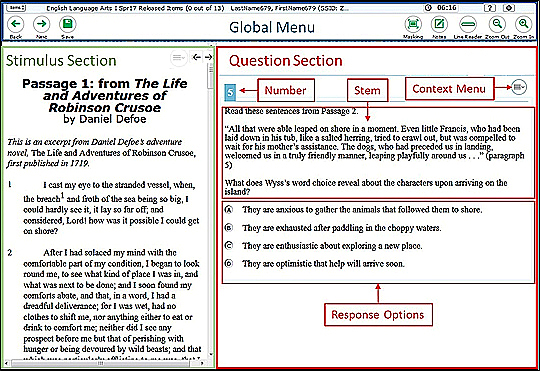
Figure 1. Sample item page
About Test Elements
A test page has up to three elements: Global menus, Stimulus section, and Question section.
- Global: This menu contains the global navigation and test tool buttons. It also includes the Questions menu, test information, [Help] [
 ] icon, [Pause] button, and [System Settings] [
] icon, [Pause] button, and [System Settings] [ ] icon.
] icon. - Stimulus: The Stimulus section appears only for questions associated with a stimulus and contains the stimulus content, context menu, and [Expand/Collapse Passage] button (for ELA passages).
- Question: Each question and item section contains the following elements:
- Question number
- Question context menu
- Question stem
- Response area and response options
Global and Context Menus
The global and context menus allow students to access on-screen tools. These tools can be accessed using a mouse or keyboard shortcuts. These keyboard shortcuts can be found in the California Assessment Accessibility Resources: Keyboard Navigation (English) video or the Keyboard Commands for Students.
Global Menu
- The global menu (figure 2) contains the navigation buttons, the global test tool buttons, and the Questions drop-down list.
- Navigation buttons ([Back], [Next], [Save], [Pause], and [End Test]) appear on the left side of the global menu.
-
Test tool buttons (such as [Help], [System Settings], [Calculator], [Notes], [Line Reader], [Zoom Out], and [Zoom In]) appear on the right side of the global menu. Some tools are available for all assessments, while others are only available for a particular content area, accessibility resource, or type of question.

Figure 2. Sample global menu
-
The Questions drop-down list (figure 3) allows the student to jump directly to an item the student has already viewed. The drop-down list will show a flag symbol (
 ) if an item has been marked for review and a triangle symbol (
) if an item has been marked for review and a triangle symbol ( ) if an item has been left unanswered.
) if an item has been left unanswered.
Figure 3. Sample Questions drop-down list
Open a Test Tool in the Global Menu
To open a test tool in the global menu, select the button for the tool (for example, [Calculator]). Most tools will open in a pop-up window.
Use the [Zoom In] and [Zoom Out] Buttons in the Global Menu
- To make text and images in the assessment larger, the student selects the [Zoom In] button. This can be done up to four times. The zoom state persists until the [Zoom Out] button is selected.
- To make the text and images in the assessment smaller again, the student selects the [Zoom Out] button.
Open the System Settings Window and Adjust the Volume, Rate, or Pitch
-
The student selects the [System Settings] [
 ] icon in the upper-right corner of the global menu next to the [Help] icon (figure 1). The System Settings window (figure 4) will open.
] icon in the upper-right corner of the global menu next to the [Help] icon (figure 1). The System Settings window (figure 4) will open.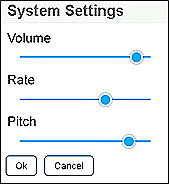
Figure 4. System Settings window
- The student moves the [Volume] slider to adjust the loudness of the audio, moves the [Rate] slider to adjust the speed of the speech, and moves the [Pitch] slider to adjust the pitch of the speech.
- The student selects [OK] to save the new volume, rate, and pitch settings for the remainder of the assessment.
Context Menus Overview
The student accesses tools such as text-to-speech, highlighter, and strikethrough using context menus. Context menus contain the options available for each different area on the test page. These areas are called elements.
Elements include passages or prompts, test items, and answer options (such as A, B, C, and D). Each answer option is a single element, and each element has its own context menu.
The context menu options vary depending on the following:
- The element type (that is, passage or stimulus, item, or answer option)
- The tools available to students (that is, accessibility resources assigned for the assessment)
Figure 5 shows an overview of the elements for multiple-choice and selected-response items and indicates that the active item number is blue and the active answer option or other element has a light blue border. Figure 6 shows a sample context menu for items. Figure 7 shows a sample context menu for answer options. Each answer option has its own context menu.
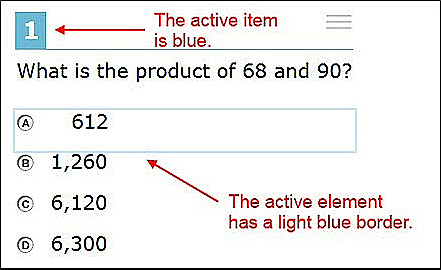
Figure 5. Overview of elements for multiple-choice and selected-response items
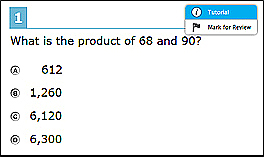
Figure 6. Sample context menu for items
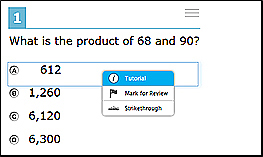
Figure 7. Sample context menu for answer options
Open a Context Menu for Passages and Items
- The student selects the [Context Menu] (
 ) icon at the upper-right corner of the passage or item. The context menu will open and display the available tools.
) icon at the upper-right corner of the passage or item. The context menu will open and display the available tools. - The student selects a tool to activate or open it.
Open a Context Menu for Answer Options
Students may use the [Context Menu] icon to view available tools for multiple-choice or multiselect answer options. A student may also select using a mouse or trackpad.
The instructions to open the context menu for an answer option using the on-screen button differ depending on the device.
Mouse or trackpad
- The student selects an answer option so that it is “active” (a light blue border will appear around it) (figure 5). However, this will result in the answer option being selected until the student selects a different option.
- The student selects the [Context Menu] icon. The context menu will open.
- The student selects a tool to activate or open it.
Tablets
- The student taps an answer option so that it is “active” (a light blue border will appear around it). However, this will result in the answer option being selected until the student selects a different option.
- The student taps the [Context Menu] icon. The context menu will open.
- The student selects a tool to activate or open it.
The student opens the context menu for an answer option using the right mouse button:
Two-button mouse
- Using the right mouse button, the student selects anywhere on an answer option. The context menu will open.
- The student selects a tool to activate or open it.
Single-button mouse (for use with Mac devices)
- The student moves the mouse to an answer option.
- On the keyboard, the student presses the [Ctrl] key while selecting the mouse button. The context menu will open.
- The student selects a tool to activate or open it.
Chromebook
- Using the trackpad, the student moves the mouse pointer to an answer option.
- The student presses and holds the [Alt] key on the keyboard.
- The student presses down on the trackpad until it “clicks.” The context menu will open.
- The student selects a tool to activate or open it.
Student Pause of Assessment
Students will take the following steps to pause an assessment:
-
Students are able to pause the assessment by selecting the [Pause] button in the global menu (figure 8).

Figure 8. [Pause] button in global menu of Student Testing Site
-
A confirmation message will appear like that shown in figure 9.

Figure 9. Student Pause Test message box
- The student selects the [Yes] button to acknowledge the message and pause the assessment. The student will be logged off and returned to the Sign In screen.
- If the student wishes to reenter the session, the student will need to sign on and proceed through the approval process again. If the session has been stopped, the student will need to obtain a new session ID to resume testing.
Student Completion and Submission of the Assessment
Students will take the following steps to end an assessment:
-
When a student has responded to the last item on the assessment, the student will select [Next] to proceed to the test review screen (figure 10).
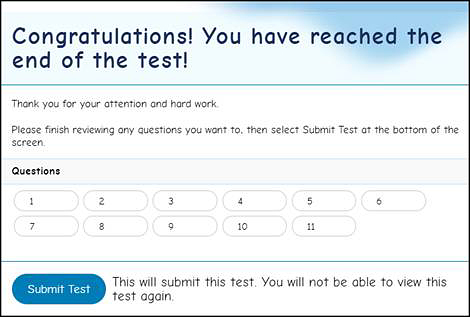
Figure 10. Review test questions
-
To go back to the assessment and review answers, the student must select an item from the list. The student is then taken back to the specific item in the assessment. The pause rule determines which items are available for review. Refer to the Student Pause of Assessment subsection to read more about pausing a student’s assessment.
- While a student is reviewing answers, the student can navigate back to the test review screen by navigating through the assessment using the [Next] button or by using the Questions drop-down list at the top-left corner of the student interface, then selecting the [Review] button.
-
To complete the assessment, the student must select the [Submit Test] button on the test review screen. When the student selects the [Submit Test] button, a message will appear on-screen (figure 11).

Figure 11. End Test message box
- The student selects [Yes] to submit the assessment. If the student wants to continue working, the student should select the [No] button. The student may also want to select the [No] button if questions were left unanswered and the student would like to revisit those questions.
-
After the student submits the assessment, the Test Summary confirmation screen (figure 12) that appears will show the student’s SSID, the test name, and the date the assessment was completed and submitted.
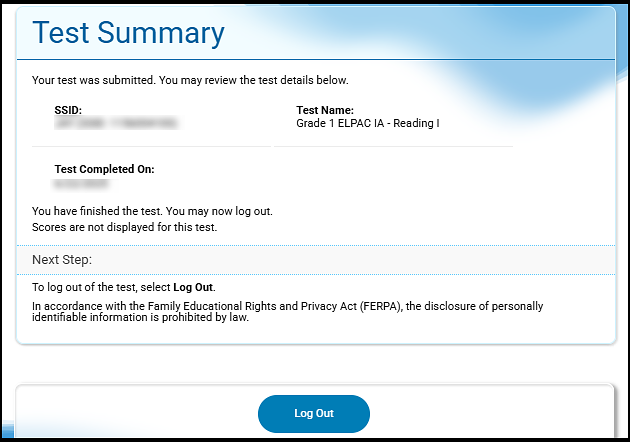
Figure 12. Test Summary confirmation screen

